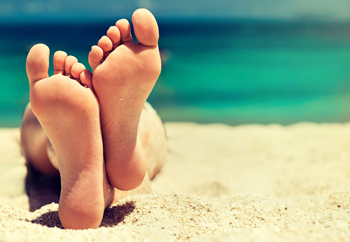 Discoloration of the skin on the feet may be a sign of poor circulation. Problems with circulation can be caused by many different conditions. Raynaud’s disease, a condition that can make the blood vessels in the hands and feet temporarily spasm and constrict, can restrict blood flow and make your feet turn blue, purple, red, or white. Lupus, an autoimmune disease, can cause an inflammation of the blood vessels called vasculitis, which can cause a rash of red or purple dots to appear on the skin. Peripheral artery disease, a condition characterized by poor blood flow to the lower extremities, can cause the feet to gradually turn purple or blue. Diabetes can have a similar effect on the feet. If you notice a discoloration in the skin of your feet, please see that you seek the care of a podiatrist.
Discoloration of the skin on the feet may be a sign of poor circulation. Problems with circulation can be caused by many different conditions. Raynaud’s disease, a condition that can make the blood vessels in the hands and feet temporarily spasm and constrict, can restrict blood flow and make your feet turn blue, purple, red, or white. Lupus, an autoimmune disease, can cause an inflammation of the blood vessels called vasculitis, which can cause a rash of red or purple dots to appear on the skin. Peripheral artery disease, a condition characterized by poor blood flow to the lower extremities, can cause the feet to gradually turn purple or blue. Diabetes can have a similar effect on the feet. If you notice a discoloration in the skin of your feet, please see that you seek the care of a podiatrist.
Poor circulation is a serious condition and needs immediate medical attention. If you have any concerns with poor circulation in your feet contact one of our podiatrists of Biebel & DeCotiis Podiatry Associates. Our doctors will treat your foot and ankle needs.
Poor Circulation in the Feet
Poor blood circulation in the feet and legs is can be caused by peripheral artery disease (PAD), which is the result of a buildup of plaque in the arteries.
Plaque buildup or atherosclerosis results from excess calcium and cholesterol in the bloodstream. This can restrict the amount of blood which can flow through the arteries. Poor blood circulation in the feet and legs are sometimes caused by inflammation in the blood vessels, known as vasculitis.
Causes
Lack of oxygen and oxygen from poor blood circulation restricts muscle growth and development. It can also cause:
- Muscle pain, stiffness, or weakness
- Numbness or cramping in the legs
- Skin discoloration
- Slower nail & hair growth
- Erectile dysfunction
Those who have diabetes or smoke are at greatest risk for poor circulation, as are those who are over 50. If you have poor circulation in the feet and legs it may be caused by PAD and is important to make changes to your lifestyle in order to reduce risk of getting a heart attack or stroke. Exercise and maintaining a healthy lifestyle will dramatically improve conditions.
As always, see a podiatrist as he or she will assist in finding a regimen that suits you. A podiatrist can also prescribe you any needed medication.
If you have any questions please feel free to contact one of our offices located in Holmdel and Middletown, NJ . We offer the newest diagnostic and treatment technologies for all your foot and ankle needs.




